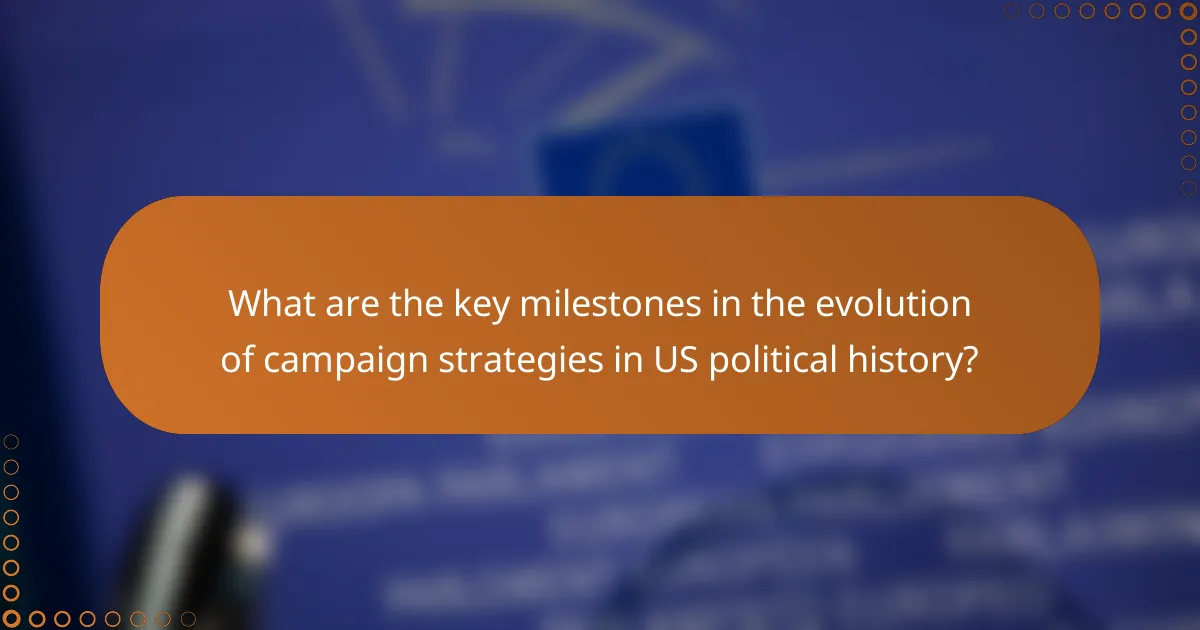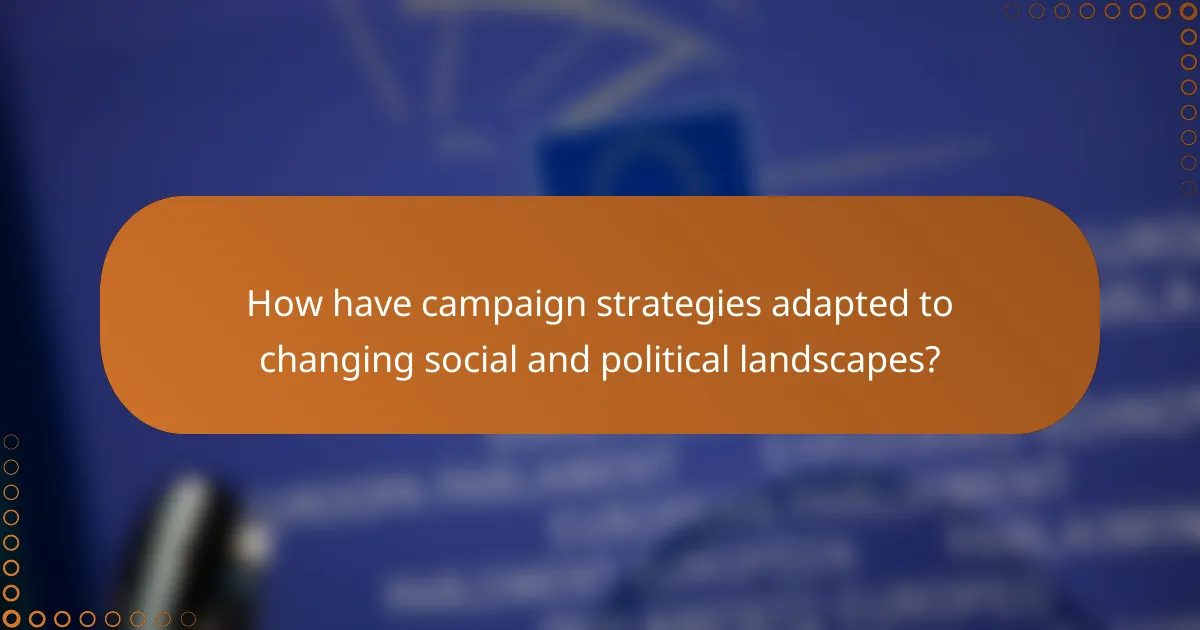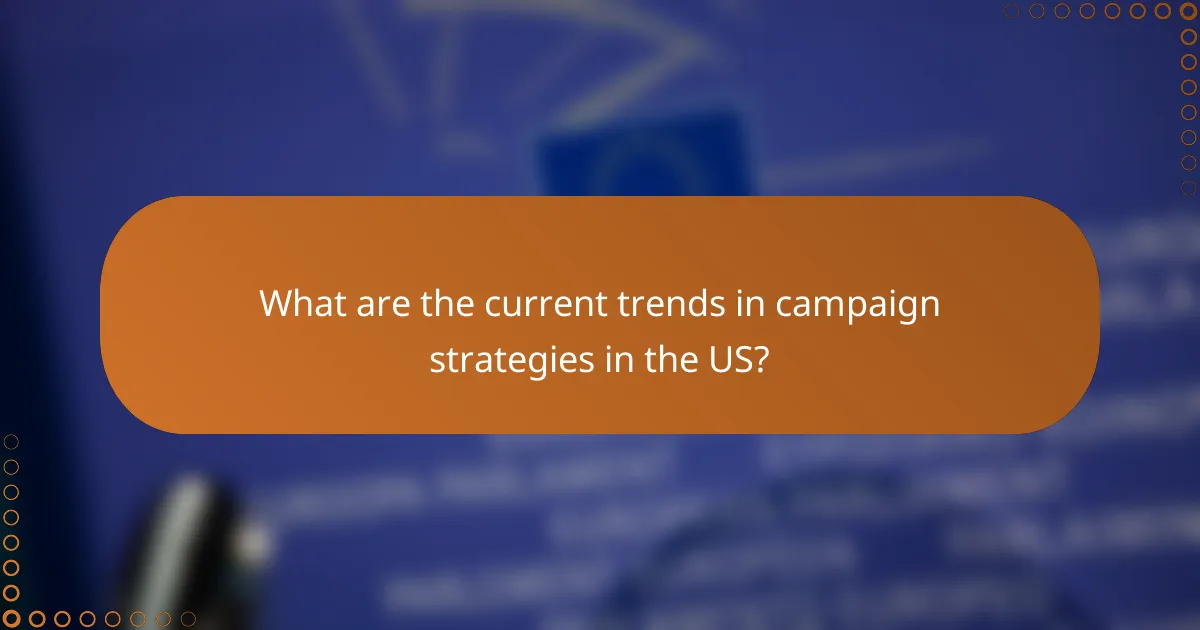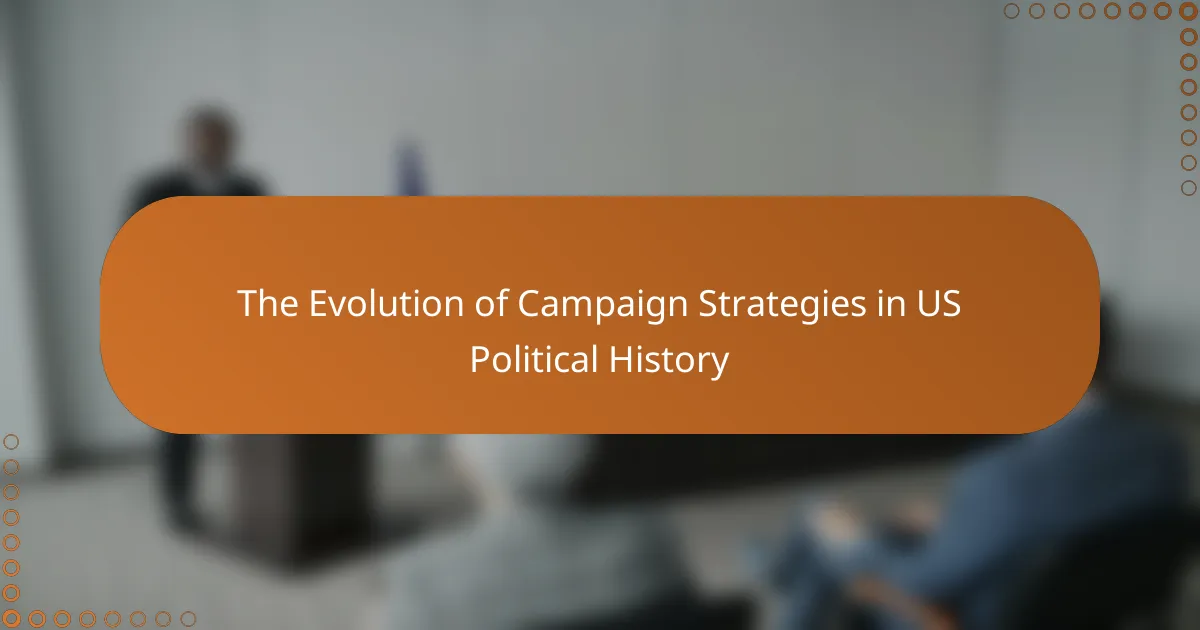The article examines the evolution of campaign strategies in US political history, highlighting key milestones that have shaped candidate-voter interactions. It details the establishment of party conventions in the 19th century, the impact of mass media in the 20th century, and the rise of digital platforms and data analytics in modern campaigns. The discussion includes the transformation of voter engagement through social media, targeted advertising, and grassroots movements, emphasizing recent trends such as video content and local issue focus. Overall, the article provides a comprehensive overview of how technological advancements and societal changes have influenced political campaigning in the United States.

What are the key milestones in the evolution of campaign strategies in US political history?
The key milestones in the evolution of campaign strategies in US political history include the establishment of party conventions in the early 19th century. These conventions centralized candidate selection and mobilized party support. The introduction of mass media in the 20th century transformed communication strategies. Radio and television allowed candidates to reach wider audiences. The use of direct mail campaigns emerged in the 1970s, targeting specific voter demographics. The rise of the internet in the 1990s revolutionized campaign outreach and fundraising. Social media platforms in the 2000s further enhanced voter engagement and grassroots organizing. Each milestone reflects a significant shift in how candidates connect with voters and convey their messages.
How did early campaign strategies shape modern political practices?
Early campaign strategies laid the groundwork for modern political practices. Techniques such as grassroots mobilization and targeted messaging emerged during the early campaigns. These strategies emphasized direct voter engagement and personalized communication. For example, the 1828 presidential campaign of Andrew Jackson utilized rallies and local events to connect with voters. This approach fostered a sense of community and loyalty among supporters.
Furthermore, early campaigns began using printed materials like pamphlets and posters to disseminate information. This practice evolved into modern advertising strategies that utilize various media platforms today. The use of slogans and catchy phrases also originated in early campaigns, influencing contemporary branding in politics.
Overall, these foundational strategies established key principles that continue to shape political campaigning, such as voter outreach and media utilization.
What were the primary methods used in the early campaigns?
The primary methods used in early campaigns included personal appearances, rallies, and printed materials. Candidates would travel to various locations to meet voters directly. This approach helped build personal connections and trust. Rallies were organized to gather large crowds and generate enthusiasm. Printed materials, such as pamphlets and posters, were distributed to convey messages and policies. These methods were effective in an era with limited communication technology. They laid the groundwork for modern campaign strategies by emphasizing direct voter engagement.
How did the media influence early campaign strategies?
Media significantly influenced early campaign strategies by shaping public perception and facilitating communication. Newspapers played a crucial role in spreading candidates’ messages and opinions. They provided a platform for political debates and discussions, impacting voter opinions. The rise of print media in the 19th century allowed campaigns to reach broader audiences. Candidates used pamphlets and flyers to disseminate their views directly to voters. Additionally, media coverage could enhance or damage a candidate’s reputation based on how events were reported. The use of political cartoons also became popular, offering satirical commentary on candidates. This media engagement was essential for mobilizing support and framing narratives during elections.
What role did technology play in the evolution of campaign strategies?
Technology has significantly transformed campaign strategies over time. It has enabled more targeted communication with voters. The rise of the internet allowed campaigns to reach a wider audience quickly. Social media platforms have facilitated direct interaction between candidates and constituents. Data analytics has become essential for understanding voter behavior and preferences. Campaigns now utilize micro-targeting to tailor messages to specific demographics. Mobile technology has increased engagement through apps and text messaging. These advancements have made campaigns more efficient and responsive to public sentiment.
How have advancements in communication impacted political campaigns?
Advancements in communication have significantly transformed political campaigns. The introduction of television in the 1950s allowed candidates to reach millions of voters instantly. For example, the 1960 Kennedy-Nixon debate showcased the power of televised appearances. Social media emerged in the 21st century, enabling direct voter engagement and rapid information dissemination. Platforms like Twitter and Facebook have changed how candidates communicate their messages. Data analytics and targeted advertising have become essential tools for campaign strategies. According to a 2020 report by the Pew Research Center, 70% of voters use social media for political information. These advancements have created a more informed electorate and reshaped campaign dynamics.
What are the significant technological innovations that transformed campaigning?
Digital advertising has significantly transformed campaigning. The rise of social media platforms has allowed campaigns to reach targeted audiences effectively. Data analytics tools enable campaigns to analyze voter behavior and preferences. Mobile technology facilitates real-time communication with supporters. Online fundraising platforms have revolutionized campaign financing. Email marketing allows for direct engagement with voters. Virtual town halls and live streaming create accessible candidate interactions. These innovations have reshaped how campaigns strategize and connect with the electorate.

How have campaign strategies adapted to changing social and political landscapes?
Campaign strategies have adapted to changing social and political landscapes by integrating technology and data analytics. Increased access to social media platforms has transformed voter engagement. Campaigns now utilize targeted advertising based on demographic data. This allows for personalized messaging to resonate with specific voter groups. Additionally, the rise of grassroots movements has shifted focus to community-based campaigning. Issues such as social justice and climate change have become central themes in recent elections. The 2008 Obama campaign is a prime example of leveraging social media effectively. It mobilized young voters through innovative online strategies. These adaptations reflect a response to evolving voter expectations and societal trends.
What factors have influenced shifts in campaign strategies over time?
Technological advancements have significantly influenced shifts in campaign strategies over time. The introduction of television in the 1950s transformed how candidates communicated with voters. For example, the Kennedy-Nixon debates in 1960 showcased the impact of visual presentation on public perception. Additionally, the rise of the internet in the 1990s changed campaigning by enabling direct voter engagement through social media and email. Data analytics have also become crucial, allowing campaigns to target specific demographics effectively. Furthermore, changing voter demographics and attitudes have prompted candidates to adapt their messages and outreach strategies. Historical events, such as economic crises or social movements, have also played a role in reshaping campaign priorities. Overall, these factors collectively illustrate how campaign strategies have evolved in response to external influences.
How have demographic changes affected political campaigning?
Demographic changes have significantly influenced political campaigning strategies. As the population has diversified, campaigns have adapted to engage various demographic groups. For instance, the increasing Hispanic electorate has led to tailored messaging and outreach efforts in Spanish. Data from the Pew Research Center indicates that Hispanic voters accounted for 13% of the electorate in 2016, up from 7% in 2000. Additionally, younger voters, who prioritize issues like climate change, have prompted campaigns to focus on progressive policies. The rise of digital media has also enabled targeted advertising to specific demographic segments, enhancing voter engagement. Overall, understanding demographic shifts allows campaigns to craft more effective strategies and resonate with a broader audience.
What impact did major historical events have on campaign strategies?
Major historical events significantly influenced campaign strategies in the U.S. Political campaigns adapted to the context of wars, economic crises, and social movements. For instance, the Civil War era saw campaigns focusing on national unity and abolitionist sentiments. The Great Depression shifted strategies towards economic recovery and social welfare. World War II campaigns emphasized patriotism and collective effort. The civil rights movement prompted candidates to address social justice and equality. Each event shaped the messaging, media use, and voter engagement tactics. Campaigns evolved to resonate with the public’s immediate concerns and aspirations, reflecting the socio-political climate of the time.
How have political parties evolved their campaign strategies?
Political parties have evolved their campaign strategies significantly over time. Initially, campaigns relied heavily on face-to-face interactions and local gatherings. With the advent of mass media, parties began utilizing radio and television for broader outreach. In recent decades, digital platforms have transformed campaign strategies, allowing for targeted advertising and social media engagement. Data analytics now play a crucial role in understanding voter behavior and preferences. For instance, the 2008 Obama campaign effectively used social media to mobilize younger voters. This evolution reflects changes in technology, communication methods, and voter engagement techniques.
What are the differences in campaign strategies between major political parties?
Major political parties in the U.S. employ different campaign strategies. The Democratic Party often focuses on grassroots organizing and digital outreach. They aim to mobilize younger voters and diverse demographics. In contrast, the Republican Party traditionally emphasizes direct mail and television advertising. They often target rural and suburban voters with their messaging.
Democrats typically advocate for progressive policies and social issues. Republicans generally focus on conservative values and economic growth. The Democratic Party has increasingly utilized social media platforms for engagement. The Republican Party often leverages traditional media to reach their audience.
Statistical data shows that Democrats have gained success in urban areas through community engagement. Republicans have maintained strong support in rural regions through local events and town halls. These strategies reflect the ideological differences and target audiences of each party.
How do party ideologies shape campaign approaches?
Party ideologies fundamentally shape campaign approaches by influencing messaging, target demographics, and policy priorities. For example, conservative ideologies often emphasize limited government and traditional values. This leads to campaigns focusing on fiscal responsibility and law-and-order rhetoric. In contrast, liberal ideologies prioritize social justice and environmental issues. Consequently, campaigns may highlight healthcare reform and climate change initiatives. Research shows that ideological alignment increases voter engagement. A study by the Pew Research Center found that voters are more likely to support candidates whose ideologies resonate with their own. Thus, party ideologies serve as a guiding framework for campaign strategies, directly impacting voter outreach and issue prioritization.

What are the current trends in campaign strategies in the US?
Current trends in campaign strategies in the US include increased use of digital platforms, data analytics, and targeted messaging. Campaigns are heavily investing in social media advertising to reach specific demographics. Data-driven strategies allow for personalized communication with voters. Video content is becoming more prevalent, especially on platforms like TikTok and Instagram. Grassroots fundraising is gaining momentum, with small donations playing a significant role. The emphasis on transparency and authenticity is also notable, as candidates seek to build trust with voters. Additionally, there is a growing focus on local issues to engage communities effectively. These trends reflect the changing landscape of voter engagement and technology’s role in campaigns.
How are social media and digital marketing influencing modern campaigns?
Social media and digital marketing are reshaping modern campaigns by enhancing engagement and targeting. These platforms allow for real-time interaction with voters. Campaigns can tailor messages based on user data. This leads to more personalized communication strategies. According to a 2020 Pew Research study, 69% of adults in the U.S. use social media. This widespread usage makes it a crucial tool for reaching diverse demographics. Digital marketing also enables cost-effective advertising compared to traditional media. Campaigns can analyze engagement metrics to adjust strategies quickly. This data-driven approach improves overall campaign effectiveness.
What platforms are most effective for political campaigning today?
Social media platforms are the most effective for political campaigning today. Platforms like Facebook, Twitter, and Instagram allow direct engagement with voters. These platforms enable targeted advertising based on user demographics and interests. In the 2020 U.S. election, over 80% of voters reported using social media for political information. Additionally, TikTok has emerged as a new space for reaching younger audiences. Email campaigns remain effective for mobilizing supporters and fundraising. Overall, digital platforms provide a cost-effective means to reach a broad audience quickly.
How do data analytics shape campaign strategies?
Data analytics shape campaign strategies by providing insights into voter behavior and preferences. Campaigns utilize data to identify target demographics effectively. This targeted approach allows for personalized messaging that resonates with specific voter groups. Analytics also track the performance of various campaign tactics in real-time. This enables quick adjustments to strategies based on what is working or not. For example, a study by the Pew Research Center indicates that 50% of voters are influenced by targeted online ads. By analyzing engagement metrics, campaigns can optimize their outreach efforts. Data-driven decisions enhance resource allocation, ensuring funds are spent efficiently.
What best practices can be derived from the evolution of campaign strategies?
Best practices derived from the evolution of campaign strategies include targeted messaging, data-driven decision making, and adaptive tactics. Targeted messaging focuses on addressing specific voter demographics. Campaigns that utilize data analytics can identify voter preferences and optimize outreach. Adaptive tactics allow campaigns to respond quickly to changing political landscapes. Historical examples, such as the 2008 Obama campaign, illustrate the effectiveness of these strategies. Obama’s use of social media and micro-targeting set new standards in political campaigning. Additionally, the evolution of campaign finance laws has shaped how resources are allocated. Campaigns that effectively manage budgets can maximize their outreach impact. These best practices have consistently proven successful across various election cycles.
What lessons can current candidates learn from historical campaign strategies?
Current candidates can learn several valuable lessons from historical campaign strategies. One key lesson is the importance of grassroots mobilization. Historical campaigns, such as those of Franklin D. Roosevelt, effectively engaged local communities to build support. Another lesson is the strategic use of media. John F. Kennedy’s 1960 campaign demonstrated the power of television in shaping public perception. Candidates should also recognize the significance of clear messaging. Ronald Reagan’s simple and relatable slogans resonated with voters and contributed to his success. Additionally, adapting to changing demographics is crucial. Barack Obama’s campaign in 2008 effectively targeted younger voters and minorities, showcasing the need for tailored outreach. Lastly, understanding the role of debates can be pivotal. Richard Nixon’s televised debate against Kennedy highlighted how appearance and demeanor can influence voter opinions. These historical examples illustrate that modern candidates can enhance their strategies by learning from past successes and failures.
How can understanding past strategies improve future campaign planning?
Understanding past strategies can significantly enhance future campaign planning. Analyzing historical campaign strategies reveals what techniques were effective and which failed. For instance, the 2008 Obama campaign utilized social media to engage younger voters, a strategy that reshaped future campaigns. Conversely, the 2004 Bush campaign’s reliance on traditional media highlighted the risks of not adapting to emerging trends. By studying these examples, campaign planners can identify patterns and avoid previous mistakes. Historical data also provides insights into voter behavior and preferences, allowing for more tailored messaging. This informed approach can lead to increased voter engagement and campaign success.
The main entity of the article is the evolution of campaign strategies in US political history. The article outlines key milestones, such as the establishment of party conventions, the impact of mass media, and the rise of digital platforms on campaign tactics. It discusses how early campaign strategies laid the groundwork for modern practices, emphasizing direct voter engagement and targeted messaging. Additionally, the article explores the influence of technological advancements, demographic changes, and historical events on campaign approaches, while highlighting current trends like data analytics and social media engagement in political campaigning.
